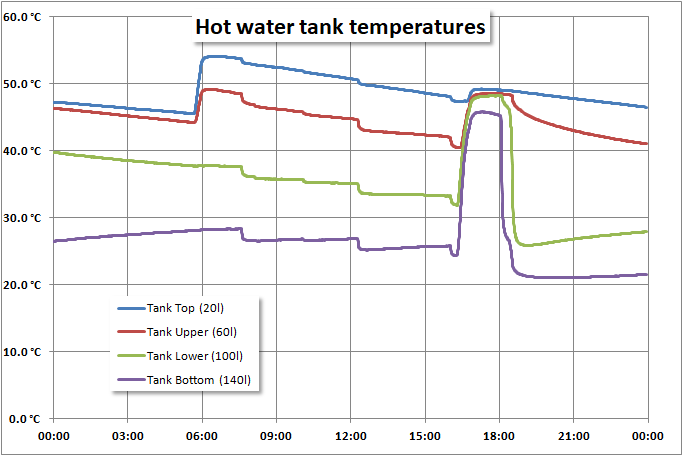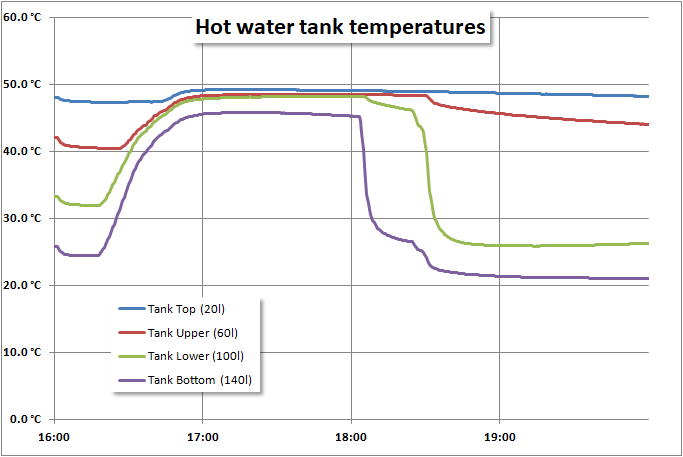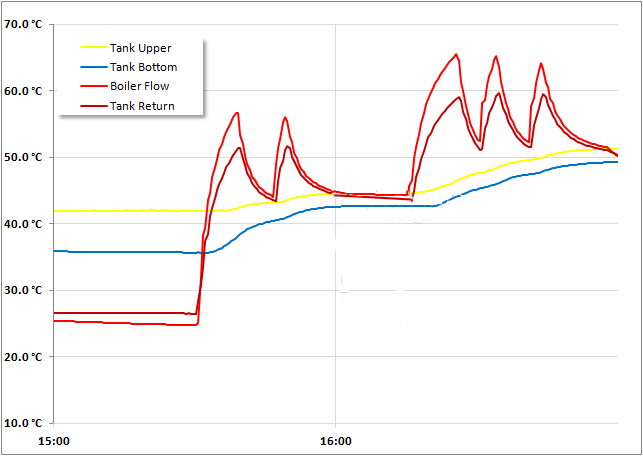It seems quite straight forward doesn’t it? You stick a thermostat on the tank. If the water is cold you turn on the boiler/heat pump and heat it back up again. What’s the problem?
Well if you know where heat is going and where it is being lost you make changes to reduce your losses.
So I have an old (ancient?) 160l copper cylinder with around 1” of crumbly foam insulation. It has an additional insulating jacket and recently I have added further insulation (10cm thick Diall insulation roll – the stuff made from recycled plastic bottles).
In June I added four temperature sensors at approximately 1/8, 3/8, 5/8 and 7/8 down from the top (this equates to around 20l, 60l, 100l and 140l of hot water above each sensor). I can also measure the indirect coil flow temperatures in and out, and the temperature of the cold water entering the tank.
The first thing to note is that water is actually quite a poor conductor of heat. You need strong convection currents or stirring/mixing to get a volume of water to a constant temperature.
The following are typical tank temperatures over the day.

The tank slowly cools over night, although the bottom of the tank warms slightly from the warmer water above (this could be because of the copper heat exchanger).
At 05:45 the top mounted immersion heater turns on for 15 minutes (0.75 kWh input). This warms the top and upper sections of the tank but barely affects the lower and bottom sensors. At around 08:00 I do the morning washing up, and again at 12:30 and 16:00.
At 16:30 the boiler is used to heat up the water. The indirect coil occupies the bottom half of the tank. The bottom heats fastest, followed by the lower than upper areas of the tank.

By 17:00 the tank is pretty well up to temperature. Since the tank has been effectively heated from the bottom, convection within the tank helps to produce a fairly uniform temperature. In fact the bottom of the tank is only a few degrees cooler than the top.
At 18:00 it’s time for a bath. Cold water enters the bottom of the tank “pushing” the warmer water up. Although the bottom has now fallen to 27°C, the lower sensor shows little change and the upper two show virtually no impact. This corresponds to a hot water draw-off of around 60l. 18:30 second a bath is run. The bottom sensor is now close to the cold water inlet, the lower has fallen dramatically and the upper sensor shows a small fall. This total usage corresponds to around 3 kWh of energy.
What does this mean regards reducing our energy
Standing losses and tank temperature
The water tank loses heat all day long. In the winter this supplements the heating, in the summer it is wasted.
Modern heat pump ready cylinders quote a daily loss of around 1 kWh (150l) to 1.6 kWh (300l). For an old copper cylinder I guess losses would be around 2 to 3 times this.
For my tank, in the above example, the daily losses were around 0.95 kWh (£25.30 per annum).
The hotter the tank the greater the losses.
There is some debate about how hot (or not) the water should be. Have a read of the Heat Geek article for an in depth discussion. One side of the argument says water should be hot (60 °C) to prevent Legionella. The other, that lower water temperatures (around 43 °C) are safer (less chance of scalding) and are more economic.
One other thought. If you use a sterilisation cycle once a week, then by the time the next cycle takes place the contents of the tank will have changes several times over.
Lessons:
- Reduce the temperature of the water in the tank to nearer 43 °C (if you are happy to do so).
- Only heat the tank when the water is (about to be) needed, use a time switch to match your demand.
These two lessons actually work well together. By heating the water just before it is needed you are minimising losses and ensuring that the water you have is at its hottest. Maybe you can turn the hot water stat down a degree or two?
How much hot water do you actually need?
At the point of use you will generally be mixing hot water with cold to generate a comfortable water temperature.
If my tank is at 43 °C then I will probably not mix any cold with the hot. 10l of hot water will fill my 10l bowl.
If my tank is at 73 °C then I will mix 5l of hot, with 5l of cold (at say 13 °C) to produce my 10l of warm 43 °C water.
- A 160l tank at 43 °C will provide 160l of usable hot water.
- A 160l tank at 73 °C will provide 320l of usable hot water (at 43 °C) when mixed with cold.
And your usage
- 10l – Washing up bowl.
- 30l – A shower.
- 70 to 130l – A bath.
So a relatively small 160l tank at 43 °C has easily enough hot water for an ample bath.
Thermostatic control
On our old copper tank the mechanical thermostat is near to the bottom of the tank (about the level of my bottom temperature sensor). It has quite a wide hysteresis (over 5 °C). However because of its position I only need to draw off a small amount of hot water (maybe just 20l), before the cold water that replaces it into the bottom of the tank will trip it. The thermal pocket on heat pump cylinders tends to be around half to two thirds the way down the cylinder (nearer to my lower sensor) so it shouldn’t trip until about one third of the hot water has been run off.
Because the indirect coil heats the whole of the tank the position of the thermostat has little impact on the final water temperature. However if the thermostat was further up the tank it would allow for a greater run-off before requesting a re-heat. Of course this also means a smaller reserve of hot water.
This also explains why systems might report a relatively cold water temperature, whereas the water drawn from the tank is still hot.
Heat up losses
When the boiler (or heat pump) turns on it must first heat the water circulating around the system. This hot water then transfers heat, through the indirect coil, to the hot water tank. This gives us several losses:
The boiler efficiency say 85 to 90%
Heat lost from the pipework (the following was obtained from Copper Tubes – Uninsulated Heat Losses (engineeringtoolbox.com)
We have around 5m of 28mm pipe-work to the tank, and 5m of 22mm pipe-work returning to the boiler. At a boiler temperature of around 65 °C that’s around 500W!
| Heat Loss W/m | ||||
|---|---|---|---|---|
| Pipe Size | Temperature difference | |||
| mm | Inches | 22 °C | 38 °C | 55 °C |
| 15 | ½ | 21 | 32 | 45 |
| 22 | ¾ | 28 | 43 | 60 |
| 28 | 1 | 34 | 53 | 76 |
| 35 | 1¼ | 41 | 64 | 89 |
A quick rule of thumb:
Power lost = 0.05 * pipe diameter (mm) * temperature difference * pipe length (m)
The longer the boiler is running or the hotter the flow temperature the greater the losses. Current installations require the pipe-work to be insulated to reduce these losses, alas mine are un-insulated.
Assuming a 30 minute heat cycle (7 kW providing around 3 kWh into the tank) this is around 0.25 kWh
Heat retained in circulating water
When the boiler turns off hot water will still be present in the pipe-work and boiler heat exchanger. Even with insulation it is likely that most of this heat will be lost. If the boiler has pump over-run the water should be nearer the tank temperature, without it, nearer the boiler temperature. Our pipe-work holds around 5l, and the boiler heat exchanger around 3l, equating to a loss of around 0.3kWh.
If the flow temperature is lower the retained heat will be less but, given it will take longer to heat the tank, the pipe-work losses may be greater.
If you are relying on the hot water tank thermostat near the bottom of the tank then you really are wasting money!
- Run off of 20l of water requires around (20l * 4.18 * (43-13) / 3600) ~ 0.7 kWh
- Losses water & pipe-work losses ~ 0.4 kWh
- Boiler efficiency 90%
- Power Used 1.22 kWh / Power into tank 0.7 kWh = 57% efficient.
Worth it? Extra boiler cycles (2 per day) * 365 * 0.4 kWh = 292 kWh = £21.30
Boiler cycling and minimum boiler power
So the boiler heats the circulating water which in turn heats the water in the hot water tank. As the tank heats up and temperature difference between the circulating water and the tank falls so less heat is transferred to the tank. The boiler must modulate down. If the minimum boiler (heat pump) output exceeds the demand then eventually the boiler must turn off. The circulating water slowly gives up its heat and eventually it cools sufficiently for the boiler to turn back on.

However if the tank temperature is such that the return temperature cannot cool enough to turn the boiler back on then the systems gets stuck. The water continues to circulate at the tank temperature (and the tank slowly cools down). The only option is to increase the boiler temperature.
In the above, a boiler set-point of 57 °C would seem to be enough to heat the tank to 50 °C, but the boiler hysteresis is around 14 °C, so when the tank reaches 43 °C the boiler cannot turn back on. Only when the boiler is set to around 66 °C can it manage to get the water tank to above 50 °C.
The boiler set-point needs to be at least 15 °C above the required water tank temperature.
In the post Heating your home – (Correct) Size is important I discussed why too large a boiler (and heat pump) can be detrimental to the performance of your heating. The same is true for the hot water. You can also get boiler short-cycling if the boiler peak output is too large.
Because my boiler’s minimum output is 7 kW, once this exceeds the power transferred to the tank the boiler must turn off. During the cooling period the circulating water temperature approaches the tank temperature and the heat transfer falls further. If the boiler could modulate down further it would spend longer heating and hence actually heat the water tank faster.
Usage Losses
All of the above relates to how to operate your hot water heating. Whenever you use hot water, then hot water is left behind in the pipe-work. It’s easy to work out how much. Wait for a reasonable time since the last time you operated a tap (several hours to let the water cool), then run the tap into a measuring jug, with a finger in the water stream. When it starts to run hot you can note the volume. This is about 2l for our kitchen tap.
- With hot water at 43 °C this equates to around 0.07 kWh
- With hot water at 60 °C this equates to around 0.11 kWh
Worth the effort? Say 3 bowls of water per day, 365 days, 0.04 kWh = 44 kWh = £3.20
Again running the tank at a lower temperature reduces these losses.
Summary
- Run your water tank at the lowest temperature you are comfortable with based on usage and/or concerns about Legionella.
- Use a timer to heat your water (just) in advance of when you need it to minimise the number of heat cycles in the day and maximise the water temperature.
- There is no need to have a tank of hot water sitting unused over night.
- Match the (minimum) boiler/heat pump output to the tank. A larger tank heat exchanger can’t hurt. Too large a boiler can take LONGER to heat your hot water
- Allow for hysteresis. Set the boiler temperature around 15 to 18 °C hotter than the target hot water temperature.
- If you have a choice of bathrooms/toilets use the one nearest the hot water tank.







